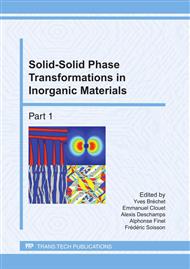p.105
p.111
p.117
p.123
p.129
p.135
p.144
p.150
p.155
Beta Titanium Alloys with Very High Ductility Induced by Complex Deformation Mechanisms: a New Material Perspective for Coronary Stent Applications
Abstract:
The increased use of metallic biomaterials in contact with blood e.g. for application as coronary stents is steadily resulting in the development of new biomaterials. Conventional bare-metal stents made by stainless steel were reported on adverse reactions against human body and are gradually replaced by coated stainless steel. The new generation of stent requires fundamental improvements at the materials point of view. Although titanium and classical Ti-alloys display superior biocompatibility compared to other metallic materials (stainless steels, Co-Cr), the major drawback of their relatively low ductility (typically 15%-25% of elongation) seriously limits their applications as cardiovascular stents, where large ductility is basically required during the stent deployment procedure and long-term service. In this paper, new titanium alloys with high ductility, a binary Ti-12Mo (wt%) and a ternary Ti-9Mo-6W (wt%) were designed by using a chemical formulation strategy based on the electronic design method called “the d-electron alloy design method”. Both alloys were synthesized and thermo-mechanically treated into beta-metastable state. In tensile tests, both alloys exhibited outstanding ductility of 43% and 46% in total elongation at room temperature, which is almost two times greater than the normal value shown with classical titanium alloys. Optical microscopy and detailed TEM observations on the deformed specimens revealed a complex deformation mechanism, involving {332}<113> mechanical twinning, stress induced plate shaped omega phase and stress induced martensitic (SIM) transformation β-α’’.
Info:
Periodical:
Pages:
129-134
Citation:
Online since:
June 2011
Authors:
Price:
Сopyright:
© 2011 Trans Tech Publications Ltd. All Rights Reserved
Share:
Citation:


